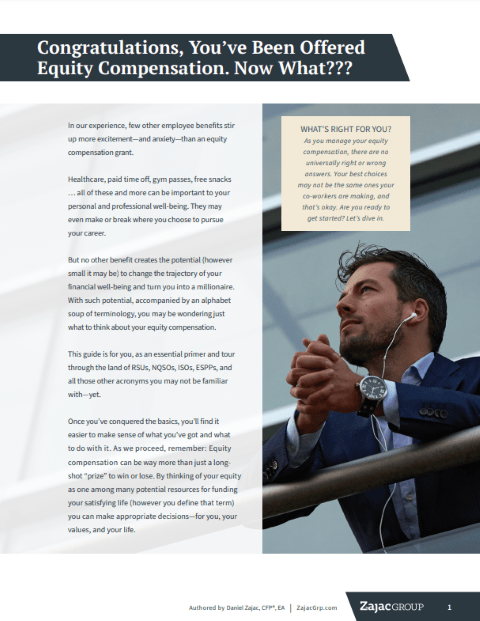If you have equity compensation as part of your benefits package, you’ve likely spent time considering when it might be best to exercise your stock options or sell your restricted stock units, seeking to maximize the value of these potential assets.
Deciding the right time to take action is complicated by several factors, including your personal goals and objectives, the rules of your employer’s plan, and the grant information on the equity you have. There’s also the unknowable variable of how the company’s stock may perform in the future.
While this may sound like bad news, it’s really just a reminder of the importance of good planning. Proactively creating a strategy for how to manage your equity compensation can put you ahead of the curve and have you prepared for what you should be thinking about as you plan to take action on your stock plan benefits.
You may also feel better knowing that while the situation can get complicated, there isn’t an unlimited number of actions you could take and need to decide on. In a short summary, there are three core choices you need to make:
- Deciding if you’ll exercise your employee stock options
- Deciding if you’ll keep the shares after you exercise, or after RSUs vest
- Deciding if you’ll sell your shares and collect the proceeds
In making your choice, you should consider the type of plan benefits you own, as the rules and the impact for each can vary widely.
For example, you may have incentive stock options, non-qualified stock options, restricted stock units, employee stock purchase plans, and so on — all of which may have a different impact on how much tax you pay, when you pay it, how it’s paid, and how much after-tax proceeds you receive.
GET THIS GUIDE
When it comes to your finances, it's important to understand what you have, what you should consider, and how it can impact your personal goals. This guide is the best place to start.
Once you’re clear on the type of equity comp you have, you can start narrowing in on the right time to take action. To help make this process more manageable, here are a few times when it may make sense to exercise, hold, or sell:
Exercise and/or Sell As Soon As Possible
For many types of stock plan benefits, the first opportunity you have to take action isn’t as soon as you get an award. It’s some date after you are awarded the stock grant, determined by your vesting schedule.
A vesting schedule states that to receive the stock grant benefits, you need to meet certain requirements. Many companies issue stock compensation with a schedule that’s tied to a period of time you must remain with the company in order to receive the value of the plan benefit.
Your first opportunity to take action is often whenever your stock options or grants are fully vested. At this point, you may want to exercise (if you have stock options or stock appreciation rights).
If you have restricted stock units (or awards) or performance shares instead, you may want to hold the shares that you now own (assuming a stock-settled award) or sell the shares at the prevailing market price.
When You May Be About to Lose the Opportunity
If you have employee stock options or stock appreciation rights of a public company, your option to exercise does not last forever. Stock options and stock appreciation rights are issued with an expiration date. If you go past that date, you forfeit the right to exercise your option.
If you have public company stock options with a grant price that is below the current fair market value of the stock and are approaching or near the expiration date, you probably need to exercise and purchase shares at your strike price so you don’t forfeit the value.
After you exercise your options, you can usually either keep the shares or sell them. You don’t need to decide until after you exercise, so if you’re unsure, don’t let that stop you from taking what’s arguably the most important step when you’re facing a “use it or lose it” situation due to an impending expiration date.
Once You’re Outside of a Lock-Up or Blackout Period
If your company recently went through an IPO, your shares may be subject to a 6-month lock-up period in which you cannot take action and sell your shares. (Some lock-up periods may be shorter or longer, but 6 months is a common timeframe.)
You may still be able to exercise some of your options during this period. You should check your plan document to be sure of the details.
A blackout period is another time that you may not be able to sell your shares. A blackout period can be set by the company even after the company is public and can restrict the sale of shares. When the blackout period is lifted, you are in an “open window” and likely have the chance to take action and sell your shares.
After You Meet Specific Holding Periods for Tax Purposes
If you have incentive stock options or qualified employee stock purchase plan shares, you may want to take action if you meet specific holding period requirements that allow for preferential tax treatment. Here’s what these requirements look like, depending on the type of equity compensation you have:
For Incentive Stock Options
- The final sale of the stock occurs at least 2 years after the grant date, AND
- The final sale of the stock occurs at least 1 year after the exercise date
For Employee Stock Purchase Plan Shares
- The final sale occurs at least 2 years after the grant date, AND
- The final sale occurs at least 1 year after the purchase date.
If you meet these standards, you have a qualifying sale or disposition. That allows you to take advantage of lower tax rates (instead of being taxed as ordinary income) on gains.
There’s a Financial Planning Reason to Act
Participating in or being on the receiving end of stock plan benefits can be a great way to generate wealth and participate in the appreciation of a company stock price.
But at some point, you’ll want to integrate the value of your company stock into your overall financial goals and objectives. This typically requires a process that meets at the intersection of tax planning, investment management, and financial planning.
Financial planning can help you address common questions:
- How much company stock do I currently own?
- How much do I need to retire?
- What are the tax implications of my decisions?
- How do I fund college for the kids?
- How do I manage, protect, and transfer my stock plan wealth most effectively?
A good time to take action on your stock plan benefits may when you’re asking these questions, or beginning to suspect you need some or all of your stock plan assets to meet your financial planning goals and objectives.
The Right Time To Take Action
Determining the right time to take action on your stock plan benefits is a personal decision that needs to consider your personal goals and objectives, your financials, and the rules and regulations set in place by your employer and by the tax code.
A good place to start may be to learn more about what stock plan benefits you have and key dates that you should be aware of. From there, you can begin to plan a timeline for when you can take action and build a strategy for what that action may be.












0 Comments
Trackbacks/Pingbacks